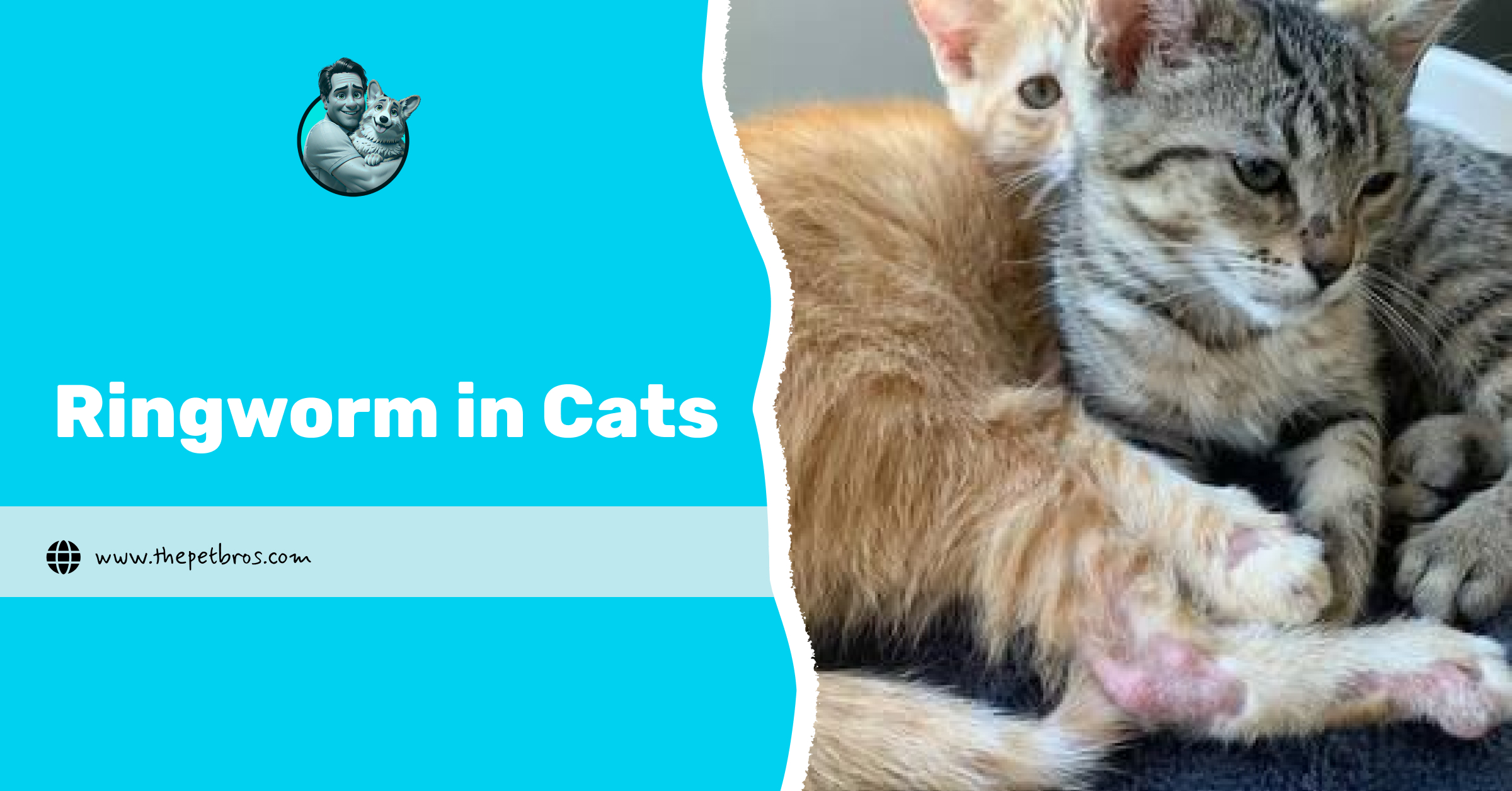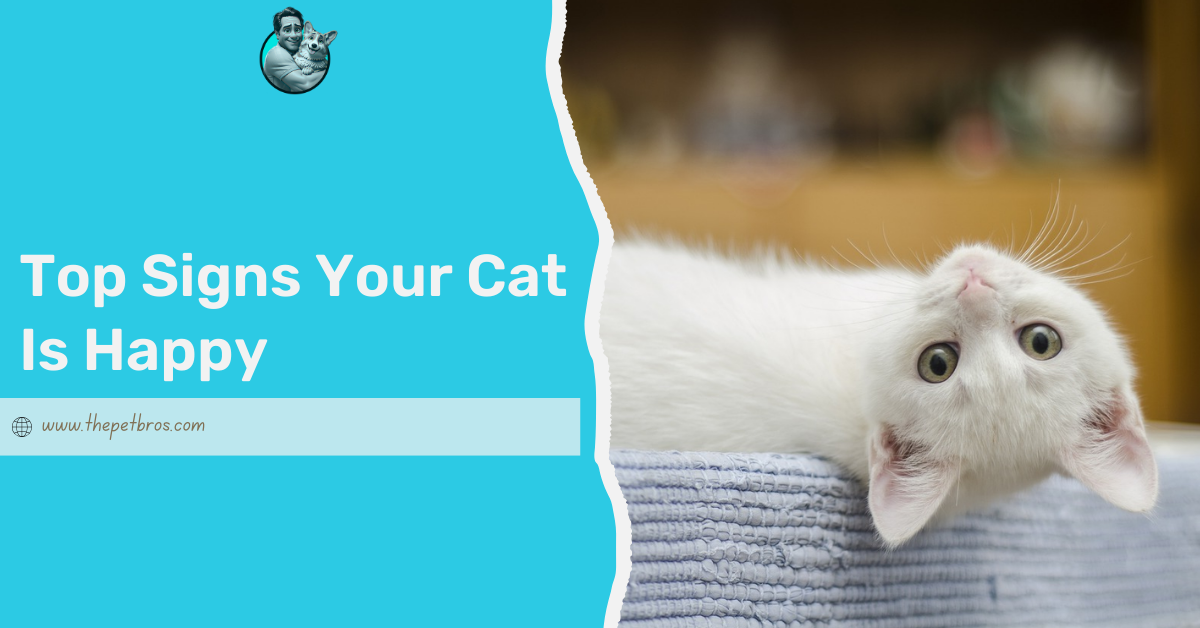Sometimes the biggest troublemakers in a cat’s life aren’t fleas or hairballs, but something far less obvious. Ringworms! See, ringworm in cats is actually a very misleading name for what is really a fungus with a flair for drama. It doesn’t crawl or wriggle like a worm, but it leaves its calling card in the form of patchy fur, scaly spots, and the occasional “what on earth is happening to my cat?” question.
Sadly, ringworm doesn’t just affect cats. It can easily spread to other pets in your home and even to you. But luckily, cats always show and carry body signs, which is why spotting the signs early and knowing how it spreads is so important.
Now, hold on, don’t panic. The good news here is that although ringworm might be stubborn, it’s totally manageable with the right care. By understanding what ringworm in cats is and what steps you can take to protect your cat, you’ll be ready to handle it before it causes chaos in your household. And that is precisely why this guide was written – let’s get right into it!
What Exactly Does it Mean for Cats to Have Ringworm?
As mentioned earlier, although it sounds terrifying, ringworm in cats is really just a fungus with drama. Despite the name, there are no worms involved at all. The real culprits are microscopic fungi called dermatophytes, which love to live on your cat’s skin, fur, and even claws. Once they’ve moved in, they leave behind their signature look, those round bald patches and flaky, irritated skin that make every cat owner scratch their head in confusion.
Kittens and cats with weaker immune systems are the most likely to fall victim, simply because their bodies aren’t as good at keeping the fungus in check. That’s why rescue centres and multi-cat households often see ringworm outbreaks. It’s a condition that can look scary when you first spot it, but knowing it’s just a fungus (and not a wriggly parasite) already makes it feel much less terrifying. And the best part? With the right treatment, most cats bounce back to their fluffy, healthy selves before you know it.
Symptoms of Ringworm in Cats
If you have ever noticed a strange patch on your cat’s fur and thought, “Hmm, that looks odd, is my cat having an allergic reaction?” you may have been looking at one of the telltale signs of ringworm in cats. The most common giveaway is a bald patch shaped a bit like a circle. The skin underneath often looks red, flaky, and irritated, almost as if your cat has developed a little scaly badge.
Another classic sign is broken or stubby fur. The fungus weakens the hairs, making them snap off far too easily. When you stroke your cat, you might feel coarse patches instead of that usual soft fluff. This is often one of the first things owners notice, because it changes the texture of their coat in such an obvious way.
Claws can also reveal the problem. While we usually think of ringworm as a skin condition, it can sometimes affect the nails, making them brittle, oddly shaped, or even crumbly at the edges. Cats may not show pain when this happens, but their claws will look far from healthy.
And here is the twist that makes ringworm infection in cats tricky: some cats carry the fungus without showing a single sign. They look perfectly fine on the outside, but the fungus is still living on their skin and can be passed on to other pets or even to people. That is why ringworm is often a surprise to owners; you do not always see it until another pet or even a family member starts itching.
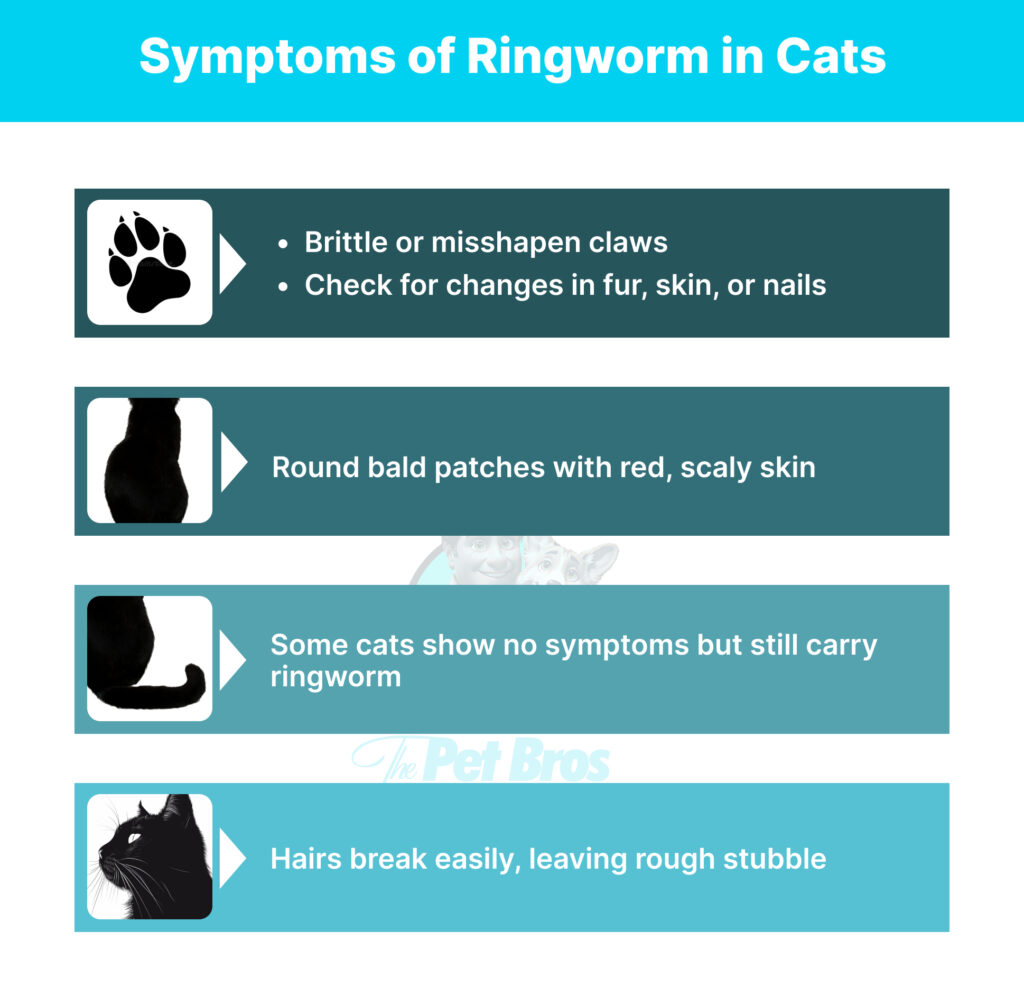
How Ringworm in Cats Spreads
One of the most frustrating things about ringworm in cats is how easily it gets around. This little fungus is not shy about making new friends. The most common way it spreads is through direct contact. If your cat brushes up against another cat, a dog, or even a rabbit that is carrying the fungus, those spores can hitch a ride straight onto your cat’s skin or fur. It is as simple as a quick sniff or a cuddle, and suddenly the fungus has found a new home.
But it does not stop there. Ringworm is sneaky because it can also spread without another animal being in sight. Spores can cling to bedding, scratching posts, brushes, or even your sofa cushions. If your cat loves to nap in their favourite spot or share toys with a furry friend, those invisible spores can easily move from one pet to another. It means even the cosiest corners of your home can become a playground for this fungus.
What really makes ringworm in cats stubborn is that its spores can survive in the environment for months. They cling to surfaces, fabrics, and even your clothes, waiting for their chance to spread again. That is why outbreaks can feel never-ending in multi-pet households if proper cleaning and treatment are not carried out.
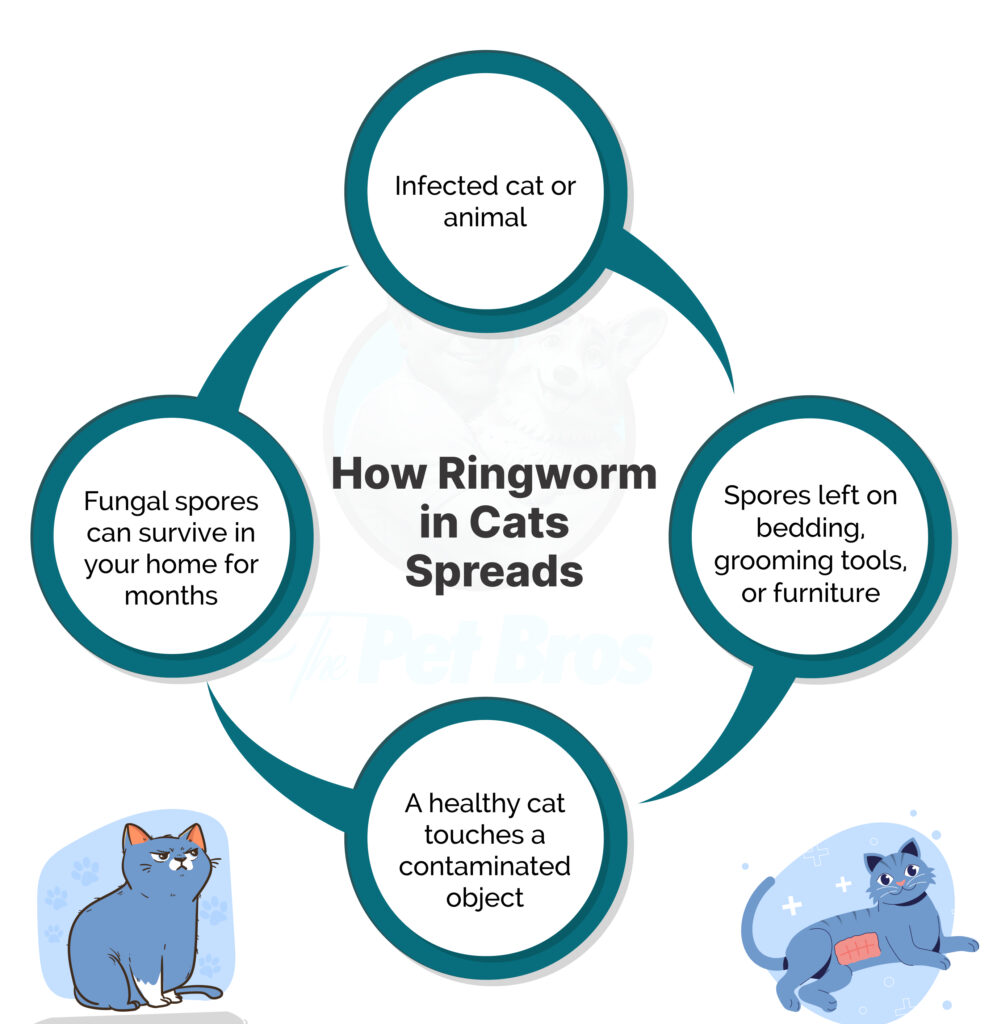
How to Diagnose Cats Suffering From Ringworm
Vets use a mix of science and experience to diagnose ringworm in cats. One of the first tools they might try is a Wood’s lamp, which shines ultraviolet light over the skin and fur. In some cases, the infected areas will glow a faint green, giving the vet a clue that fungus could be present. However, not all ringworm strains glow, so this test alone is not always reliable.
To get a more accurate answer, vets often take hair or skin samples and place them in a fungal culture. This process allows the fungus to grow in a controlled environment so it can be properly identified. It can take a little time, but it gives one of the clearest results. Microscopic tests are also useful, as spores and broken hairs can sometimes be spotted right away under a powerful lens.
A professional diagnosis matters because ringworm in cats can look very similar to other skin conditions, such as mange, flea allergies, or even bacterial infections. Treating the wrong problem not only wastes time but can also make your cat’s skin worse. That is why it is always safest to have a vet confirm the condition before starting any treatment.
How to Prevent Ringworm in Cats
Prevention is always easier than treatment, and the same goes when your cat struggled with ringworms. The good news is that with a few simple habits, you can lower the risk of your cat catching or spreading the infection. It all comes down to keeping things clean, being a little watchful, and making sure your cat stays healthy.
- Keep your cat’s environment clean and comfortable. A tidy, dry space makes it much harder for ringworm spores to survive.
- Wash bedding, blankets, and grooming tools regularly. Spores love to cling to fabrics and brushes, so freshening them up often helps keep infections away.
- If one of your cats becomes infected, separate them from the others until they’re treated. Ringworm can easily pass between pets through direct contact or shared spaces.
- Take your cat for routine vet check-ups. Regular visits mean any skin problems are spotted early, and your vet can offer advice to keep your cat’s coat in top shape.
How To Treat Your Cat Suffering From Ringworm
Dealing with ringworm in cats might sound scary, but the good news is it’s very treatable with the right care and a little patience. This skin condition can be annoying for your furry friend and frustrating for you, but once you know the steps, recovery becomes much easier.
The first step in treating ringworm in cats is usually topical treatment. Your vet may suggest antifungal creams or special medicated shampoos to soothe the skin and fight off the fungus. Bath time might not be your cat’s favourite activity, but regular washes can speed up healing and stop the infection from spreading.
For more stubborn cases of ringworm, oral antifungal medicine may be needed. These treatments work from the inside out and give your cat’s immune system the boost it needs. It’s important to stick to the full course of treatment, even if your cat looks better after a week or two. Stopping too early could let the fungus sneak back.
Cleaning your cat’s environment is just as important as the medicine. Wash their bedding, disinfect grooming tools, and give the house a good vacuum to clear away lingering spores. This not only helps your cat heal faster but also keeps other pets and family members safe.
With consistent treatment and a little extra cleaning, most cats bounce back in just a few weeks. Their fur grows back, their skin clears up, and life goes back to normal. Treating ringworm in cats may take you paying extra attention, but the results are worth it when you see your cat happy, healthy, and comfortable again.
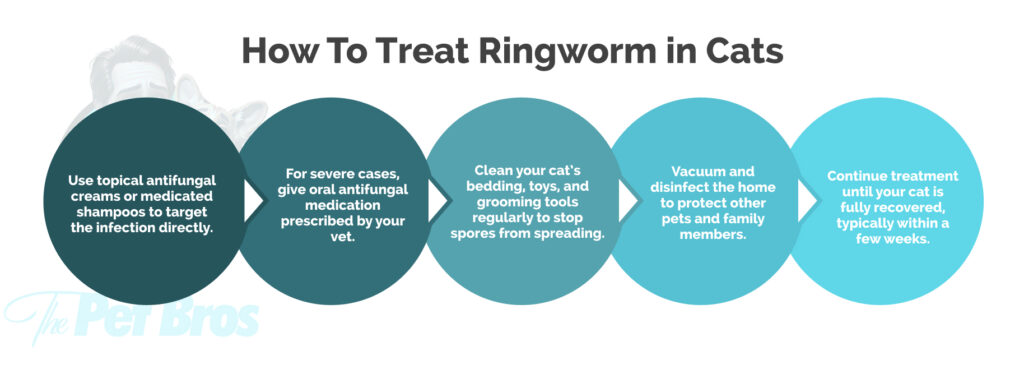
Conclusion
Ringworm in cats may sound scary, but it is just a bump in the road. With the right treatment and a bit of cleaning, your cat will bounce back before you know it. Imagine how nice it will feel when your cat is curling up beside you again, itch-free and happy. Stay calm, stay consistent, and soon this little chapter will be nothing more than a story you tell with a smile. And who knows, your cat might even thank you with a few extra purrs for being such a superstar carer.
FAQs
How do you know if your cat got ringworm?
Look for patchy bald spots, scaly skin, or get a vet’s diagnosis.
Can humans get ringworm from cats?
Yes, it’s contagious to people and other pets.
How to stop ringworm from spreading?
Clean surfaces, wash bedding, and isolate the infected cat.
How long does ringworm last in cats?
With treatment, around 2–6 weeks. Without it, it may linger for months.
Is it okay to touch a cat with ringworm?
Avoid contact where possible, use gloves, and wash your hands.
How to clean a house after cat ringworm?
Disinfect surfaces, wash fabrics, and vacuum often.






